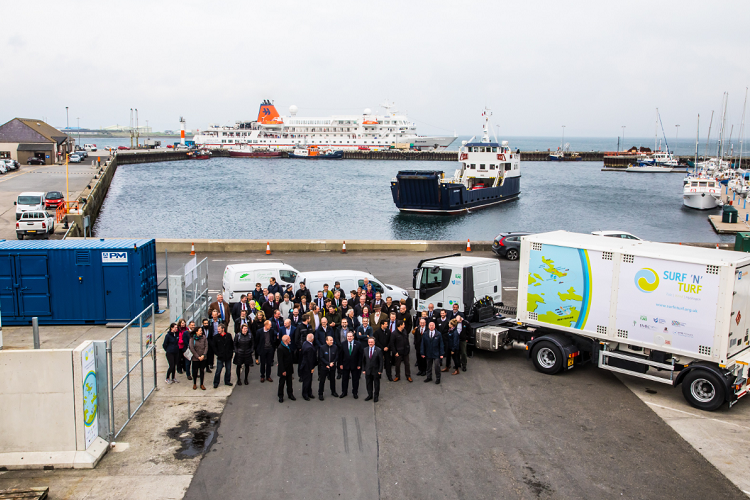Ferguson Marine to develop renewables-powered hydrogen ferry – HySeas III

Port Glasgow-based Ferguson Marine Engineering Limited has successfully led a European consortium in a bid for EU funding support to pave the way for the building and launch of the world’s first sea-going car and passenger ferry fuelled by hydrogen. The supported development is expected to cost around €12.6 million.
The vessel’s fuel will be produced from renewable electricity marking a paradigm shift towards entirely emissions-free marine transport.
HySeas III is jointly led by Ferguson Marine and the University of St Andrews and includes Orkney Islands Council, Kongsberg Maritime (Norway), Ballard Power Systems Europe (Denmark), McPhy (France); DLR (the German aerospace agency) and Interferry (Belgium/US), the world’s largest ferry owners’ organisation.
Employing Ballard technology, already proven across millions of miles of road transport, the initial objective is to construct and prove the vessel’s modular drive train onshore, testing for stress and durability under conditions employing real-world data from existing vessels.
Orkney
The successful test will allow a vessel to be constructed, in the already assured knowledge that such a vessel can operate safely and efficiently around Scotland’s challenging coast. The vessel is planned to operate in and around Orkney, which is already producing hydrogen in volume from constrained –hence otherwise wasted – renewable energy.
HySeas III Communications Manager, John Morgan of Ferguson Marine, said: “We are aiming to launch the first Hydrogen ferry by 2021. There are a few European groups in the market with similar ambitions, but we believe ours can be the first vessel on this scale and we still expect to be the world’s first vehicle and passenger Hydrogen ferry.”
Ferguson Marine Chief Executive, Gerry Marshall, added: “We now have one of the most innovative and competitive shipyards in Europe, from which we plan to deliver great things for Inverclyde and Scotland. HySeas III is a living example of how it can be possible to lead the world.”
Project Coordinator, Dr Martin Smith, from the University of St Andrews, said: “This is a very exciting stage to be at now. This opens the real possibility of Scotland and her key European partners delivering another world-first, not simply in shipbuilding but also in building sustainable local sources of fuelling in parallel.”
Jim McColl OBE, Chairman and Chief Executive of yard owners Clyde Blowers Capital, commented: “Ferguson’s was the last full-service commercial shipyard on the River Clyde. Since taking over in 2014, we have invested £25 million to bring the yard up to the world-class standards that provided the confidence in leading this hugely important, ground-breaking project.”

Scottish Government Minister for Transport and the Islands, Humza Yousaf, said: “I’m delighted to see Ferguson Marine Engineering Ltd (FMEL) play their part in winning this landmark bid.
“It’s exciting to see the FMEL shipyard getting involved in such an innovative project, joining forces with other public and private sector partners from across Europe to take forward the plans for the world’s first vehicle and passenger hydrogen ferry.
“The Scottish Government published our Climate Change Plan earlier this year, setting out a package of policies and proposals to continue delivering Scotland’s high ambitions in this area and recently set out proposals to increase our climate targets from 2020 to 2050 through the Climate Change Bill. HySeas III is the kind of ground-breaking project that fits those ambitions.
“This project will also help showcase the skills and facilities on offer at the shipyard. I will be following it with great interest and look forward to seeing Scottish expertise delivering a world first.”
Innovative partnership
In 2012, Ferguson’s launched the MV Hallaig, the world’s first battery hybrid ferry. The redeveloped yard achieved another first in November 2017 when it launched the MV Glen Sannox, the first UK ferry build with dual-fuel capability (marine diesel and LNG). The Glen Sannox sister vessel is currently under construction at the shipyard.
The University of St Andrews, the third oldest university in the English-speaking world, is home to world-class research and development in hydrogen, battery and other energy technologies. A key part of the development aspect is the transferal of knowledge and expertise into real-world applications – not least in stretching the boundaries of what has previously been thought of and achieved.
Dr Smith from the University, along with Jim Anderson at CMAL (Caledonian Maritime Assets Limited) initiated the HySeas programme in 2012. Support from Scottish Enterprise allowed the idea to be taken from an early feasibility study to the point where the focus can now shift into test and delivery.
Dr Smith previously played a leading role in the introduction of hydrogen buses into Scotland, a development which is now set to move beyond Aberdeen with Dundee currently following and other Scottish cities considering fleets of their own.
The HySeas III project formally begins on 1 July 2018.
Category Public interest stories